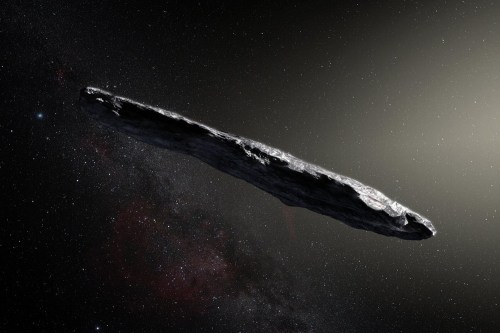
Last November, astronomers detected an outer-space object unlike anything detected before. The visitor, dubbed Oumuamua (pronounced “oh-MOO-ah-MOO-ah”), arrived from interstellar space, beyond the bubble-like region that demarcates the sun’s domain. Its unusual origin story wasn’t the only thing that set Oumuamua apart from other comets and asteroids — it was also strange in shape; highly elongated, like a cosmic cigar.
Well, this week, the story of Oumuamua got a little bit weirder. According to researchers from the Harvard Smithsonian Center for Astrophysics, the outer-space object may not be an comet after all. In a paper set to be published next week in The Astrophysical Journal Letters, astrophysicists Avi Loeb and Shmuel Bilay claim Oumuamua could be, “a fully operational probe sent intentionally to Earth vicinity by an alien civilization.”
Yes, really.
“Oumuamua deviates from a trajectory that is solely dictated by the Sun’s gravity,” Loeb tells Digital Trends. “This could have been the result of cometary outgassing, but there is no evidence for a cometary tail around it. Moreover, comets change the period of their spin and no such change was detected for Oumuamua. The excess acceleration of Oumuamua was detected at multiple times, ruling out an impulsive kick due to a break up of the object. The only other explanation that comes to mind is the extra force exerted on Oumuamua by sunlight. In order for it to be effective, Oumuamua needs to be less than a millimeter in thickness, like a sail. This led us to suggest that it may be a light-sail produced by an alien civilization.”
“I welcome other proposals,” Loeb added, “but I cannot think of another explanation for the peculiar acceleration of Oumuamua.”
Let’s break this down. Loeb is saying that the Oumuamua doesn’t exhibit the type of characteristics seen in other comets and asteroids. Not only is it the first-ever interstellar asteroid or comet detected by astronomers while passing through the solar system, its shape is strange, its acceleration is unexpected, and a cometary tail — the signature trail of particles seen behind shooting stars — is conspicuous in its absence.
The light-sail Loeb thinks may power Oumuamua is not unlike technology being developed currently here on Earth. In fact, Loeb is an adviser on Breakthrough Starshot, an ambitious mission to develop and deploy this technology. So, if the idea seems far-fetched, it’s not unthinkable.
If nothing else, Loeb hopes this story serves as a vehicle to make the Search for Extraterrestrial Life Institute (SETI) more mainstream through evidence-based science.
“Looking ahead, we should search for other interstellar objects in the sky,” Loeb said. “Such a search would resemble my favorite activity with my daughters when we vacation on a beach, namely, examining shells swept ashore from the ocean. Not all shells are the same, and similarly only a fraction of the interstellar objects might be technological debris of alien civilizations. But we should examine anything that enters the solar system from interstellar space in order to infer the true nature of Oumuamua or other objects of its mysterious population.”
Editors' Recommendations
- Remember that alien comet? Scientists figured out what it’s made of
- Astronomers found a comet that may have come from another solar system